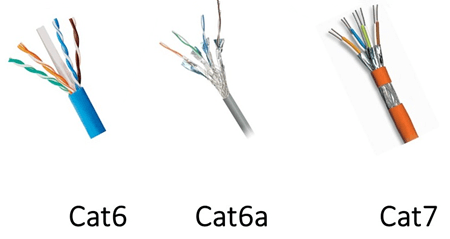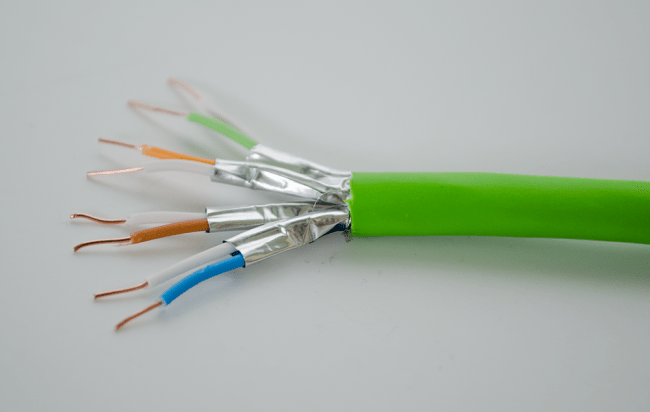Today, there is an increased demand for faster internet and data transfer speeds across a wide range of commercial and industrial sectors. Cat7 cable is intended to support much higher frequencies of signals than the Cat5e and Cat6 cables.
A Category 7 cable (Cat 7 cable) is a shielded twisted pair cable that is used in high-speed Ethernet-based computer networks of 1 Gbps or higher between directly connected servers, switches, and computer networks. The ISO/IEC 11801:2002 Class F specification defines and specifies it. Cat7 cable ethernet cable types and speeds are backward compatible with Cat 6, Cat 5/e cabling standards, and Cat5/e equipment.
Contents
- 1 What are CAT 7 cables used for?
- 2 Features and specifications of Cat7 cables
- 3 What are the types of Cat7 cables?
- 4 What is the difference between Cat6 and Cat7 cables?
- 5 FAQs
- 5.1 1. Is Cat7 faster than Cat6?
- 5.2 2. What does the A stand for in Cat7a?
- 5.3 3. What do UTP, SFTP, FTP, STP, and SSTP mean for Cat7 cables?
- 5.4 4. Can Cat7 cables be used domestically?
- 5.5 5. Is an unshielded Cat7 cable better than a shielded Cat7 cable?
- 5.6 6. Are there Cat8 cables?
- 5.7 7. Can Cat7 cable be spliced?
What are CAT 7 cables used for?
Cat7 cable is a high-end patch cable used to deliver the wired Gigabit Ethernet setups’ core infrastructure. Some common examples include:
Ethernet cables
Cat7 Ethernet cables (LAN cables) are used to connect modems, hubs, and individual computers on networks of all shapes and sizes.
Commercial and industrial applications
Cat7 cables can withstand various hazards, including temperature extremes, UV/moisture exposure, and direct contact with different chemicals and oils.
Domestic Applications
Cat7 cables have become increasingly popular with home users across a wide range of domestic Cat7 LAN cable networks and connectivity setups, in addition to enthusiast gaming setups.

Cat7 LAN cable
Features and specifications of Cat7 cables
ISO/IEC 11801:2002 specifies Cat7 Ethernet cable specifications. Because Cat7 cable is sometimes referred to as an ISO Class F cable, the Cat 7 cable specification is also known as the Class F standard.
1. Cat7 cable transmission rate
Cat7 wire was designed to support 10 Gbps Ethernet, but laboratory tests have demonstrated that it can transmit up to 40 Gbps at 50 meters and even 100 Gbps at 15 meters. Cat7 Ethernet cable speed is 10.000 Mbit/s.
In terms of raw performance versus previous revisions, this is theoretically six times greater than Cat5e (100 MHz) and 2.4 times greater than Cat6 (250 MHz).

Category-wise specification
2. Cat7 cable specifications
In 2002, Cat7 wire cabling standards were ratified, allowing 10 Gigabit Ethernet Cat7 cable diameters of over 100m of copper cabling. Cat7 maximum length, like Cat5e, Cat6, and Cat6A, has a maximum distance of 328 feet (100 meters).
Category 7 wire has four shielded twisted copper pairs and an overall cable shield. This helps it meet the strict signal loss over distance criteria and ensures Cat7 cable is better at protecting against possible degradation caused by crosstalk and EMI.

Cat7 network cable
What are the types of Cat7 cables?
The following are different types of ethernet cables in Category 7:
1. Cat7a Cable
Cat7a is an abbreviation for ‘Category 7 augmented.’ It is defined at frequencies up to 1000 MHz in ISO 11801 Edition 2 Amendment 2 (2010). Cat7a Ethernet cables are typically slightly thicker due to additional shielding designed to boost them to 1000 MHz speeds.
2. RJ45 Cat7 cable
Most Cat 7 Ethernet cables are already terminated at both ends with an RJ45 jack for immediate plug-and-play use. This is the plug required by the cable sockets on any standard home router or LAN cable switch and is a standard in almost all Ethernet connectivity setups.

RJ45 Cat7 cable
3. Cat7(a) UTP Cable
Cat7(a) UTP cable refers to an Unshielded Twisted Pair design. The four pairs of twisted copper wires that comprise a Cat7 Ethernet cable are sheathed only by their own interior jacketing and that of the external cable in this configuration.
4. Cat7(a) F/UTP Cable
Like the UTP design discussed above, the F/UTP cable (Foiled/Unshielded Twisted Pair) has no additional shielding around the twisted wire pairs themselves. Still, a single foil screen beneath the cable’s exterior jacketing encases the four pairs collectively.
5. Cat7(a) STP and FTP Cat7 Cable
These acronyms stand for Shielded Twisted Pair and Foiled Twisted Pair, respectively. STP and FTP indicate that the cable is provided with extra wrapping around every pair of twisted wires made of protective foil screening.

Cat7 F/STP Transmission Specification
6. SFTP Cat7 Cable and SSTP Cat7 Cable
SFTP (Shielded Foiled Twisted Pair) or SSTP (Shielded Spliced Pair) (Shielded Screened Twisted Pair). Cat7(a) SFTP or SSTP designates twisted pairs with a foil shield/screen between the outer cable jacketing and the inner wires, as well as an additional wrapping around each twisted pair individually.

SSTP Cat7 cable
What is the difference between Cat6 and Cat7 cables?
The physical makeup of the Cat7 cable is similar to that of the previous Cat6 cable. Both versions employ the same twisted and sheathed four-pair cable design, which is capable of carrying 10 Gbps Ethernet signals spanning distances up to 100m.

Cat6 v Cat7
Cat7 has been double-shielded to meet more stringent specifications. They are better shielded against EMI and crosstalk.
The primary difference between Cat6 and Cat7 is the speed and frequency. As you may know, the maximum Cat7 or Cat7a speed is 10.000 Mbit/s, and a Cat6 cable has a maximum speed of 1.000 Mbit/s.
Furthermore, Cat7 has a higher frequency than Cat6. As a result, a CAT 7 shielded ethernet cable will be able to transfer data faster than a Cat6 cable. The Cat 7 shielded cable performance and longevity criteria are also more stringent.
It would be deceptive to claim that one was “better” than the other. As with so many other products of this type, it’s all about selecting the best one for the job, under the conditions you require, and at the most cost-effective price for meeting those requirements.

Cat5 v Cat6 v Cat7 Specifications
FAQs
1. Is Cat7 faster than Cat6?
The main distinction between Cat6 v Cat7 is the increased bandwidth and improved shielding. Cat7‘s maximum speed is 10.000 Mbit/s, and Cat6 cables have a maximum speed of 1.000 Mbit/s. Furthermore, the Cat7 frequency is higher than the Cat6. As a result, a Cat7 cable can transfer data faster than a Cat6 cable.
Suppose you need to increase your internet speed or connect additional appliances. In that case, Cat7 standard cables are the way to go, while Cat6 cables provide enough speed to run most of the connected applications and devices in your home or office.

2. What does the A stand for in Cat7a?
The “A” in Cat7 denotes Augmented, which includes shielding for each twisted pair as well as overall shielding (S/FTP). Cat7a, or enhanced class F, is the most recent recognized standard network cable defined by the IEC/ISO in 2010.
The additional jacketing allows for higher bandwidth of up to 1000 MHz. Individual pairs of wires are shielded with foil to prevent electromagnetic interference (EMI), which is critical in electrically noisy environments like data centers. The overall braided shielding that wrapped around all four pairs provided additional EMI protection. Once terminated, the Cat7A cable includes a drain wire to ground the electricity.
3. What do UTP, SFTP, FTP, STP, and SSTP mean for Cat7 cables?
These prefixes refer to the various wire shielding configurations used inside the cable body:
Cat7(a) UTP Cable: Unshielded Twisted Pair design provides adequate EMI and signal attenuation protection to meet the baseline requirements for this standard.
Cat7(a) F/UTP Cable: Foiled/Unshielded Twisted Pair cable provides slightly more protection against signal loss than UTP versions.
STP CaT7 cable and FTP CaT7 cable: Shielded Twisted Pair or Foiled Twisted Pair cable is a step closer to maximum security.
SFTP Cat7 Cable and SSTP Cat7 Cable: Shielded Foiled Twisted Pair or Shielded Screened Twisted Pair provide the most comprehensive level of additional signal protection.
4. Can Cat7 cables be used domestically?
Yes, many people were early adopters of Ethernet connectivity in the home hub and naturally looked to the most recent versions when replacing or upgrading older cables. For example, those planning to wire a smart home today may prefer Cat7 and Cat7a, anticipating the continued acceleration of home hardware and connection speeds in the coming years.
Cat7 and Cat7a versions are significantly thicker, stiffer, and heavier than their Cat5 predecessors, which may limit your ability to route the cables neatly in areas where space is limited or very precise bends are required.

Cat7 wire cable
5. Is an unshielded Cat7 cable better than a shielded Cat7 cable?
Cat7 UTP cable The Unshielded Twisted Pair cable comprises four pairs of twisted copper wires that are sheathed only by their own interior jacketing and that of the Cat7 external ethernet cable. UTP Cat7 cable is typically the most cost-effective version of Cat7 and Cat7a Ethernet cable, with adequate EMI and signal attenuation protection.
Cat7 STP cableand FTP cable. Shielded Twisted Pair and Foiled Twisted Pair have a protective foil wrapped around each pair of twisted wires inside. Again, this is a step closer to optimal protection than the previous version.

Unshielded vs. Shielded Cat7 cables
6. Are there Cat8 cables?
Category 8, or Cat8, cable, is a type of Ethernet cable that is distinct from other cables. It can operate at a frequency of up to 2 GHz (2000 MHz). This is the main difference between Cat7 and Cat8. Cat 8 ethernet cable is restricted to a 30-meter 2-connector channel. It also necessitates shielded cabling.

Cat 8 Cable in comparison to previous models
The most important consideration is that it can carry up to 35 or 40 Gbps. Overall, its physical appearance is comparable to lower-tier cables. They are the best Ethernet cables for long distances and can be terminated in RJ45 or non-RJ45 connections. It is backwards compatible with all previous versions. It is compatible with previous versions’ standard connectors, such as Cat-7.

Cat 8 cable in comparison to previous models
7. Can Cat7 cable be spliced?
Splicing Cat7 cable while retaining full Cat7 performance can be challenging. If done correctly, the endpoints should be able to negotiate a 10G connection.
This can be done under a stereomicroscope in a suitable fixture by laser welding the wire ends together. There would be no soldering, and the splice would be staggered, with one pair spliced every inch or two. This is to reduce crosstalk.














